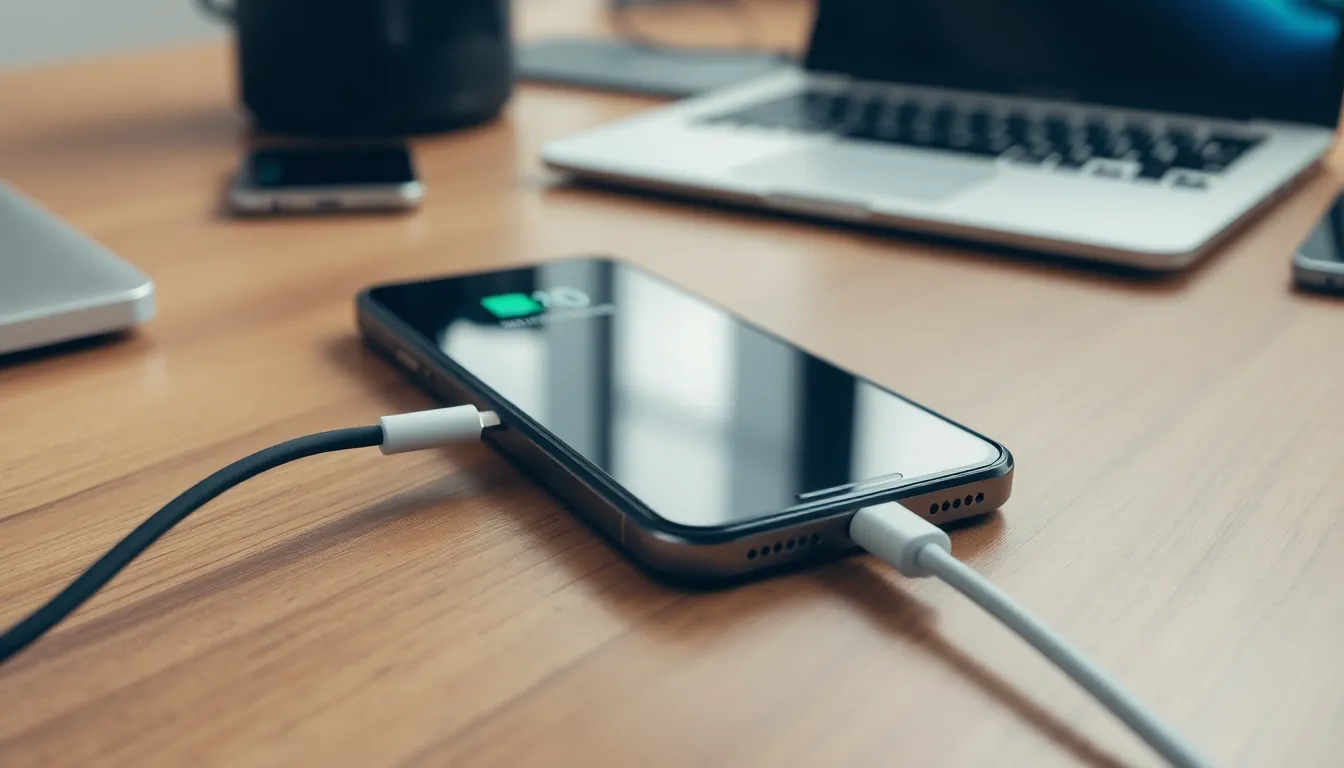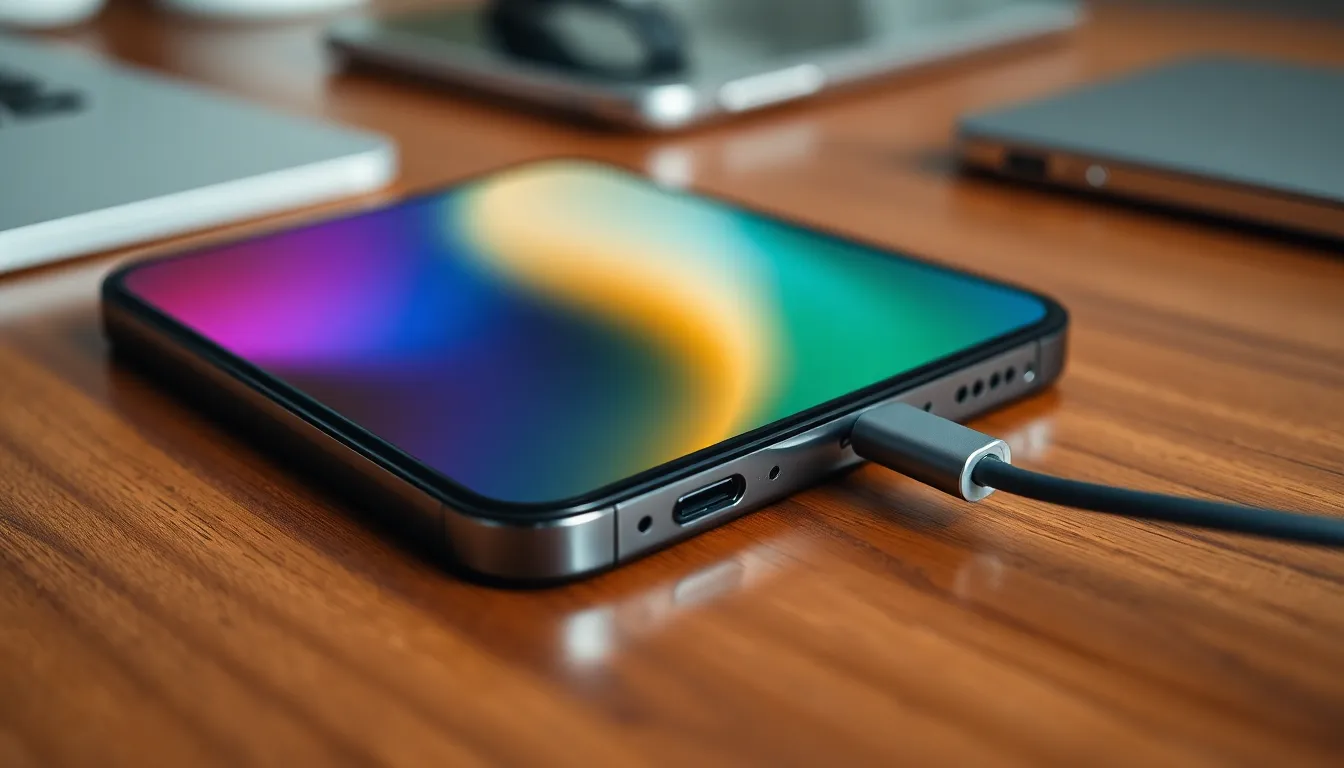Table of Contents
ToggleThe tech world buzzes with excitement as the iPhone 16 approaches. Apple fans are on the edge of their seats, eagerly waiting to see if this new marvel will finally embrace the USB-C connector. After all, who wouldn’t want to ditch the lightning cable and join the universal charging revolution? Imagine the joy of using one cable for all your devices—it’s like finding a unicorn in a sea of chargers.
Overview of iPhone 16 Features
The iPhone 16 introduces several enhancements that excite users. Key features include improved battery life, which extends usage beyond previous models. Enhanced camera capabilities elevate photography standards with better low-light performance and advanced image processing.
The display offers a vibrant Super Retina XDR screen, ensuring stunning visuals for videos and games. Additionally, the device leverages A17 Bionic chip technology, providing faster processing and improved graphics.
In conjunction with these upgrades, reports suggest iPhone 16 incorporates USB-C connectivity. This change promises compatibility with a variety of devices, allowing for a more seamless charging experience.
Users benefit from increased data transfer speeds alongside streamlined accessory integration. With this move, Apple aligns itself more closely with industry trends and user demands for universal connectivity.
The design also features refined aesthetics, maintaining the sleek, modern look Apple is known for. Advanced security options, including upgraded Face ID and potential under-display Touch ID, enhance user convenience and safety.
Overall, the iPhone 16 appears to embody a significant evolution, focusing on versatility and user experience.
Transition to USB-C

The iPhone 16’s potential shift to USB-C marks a significant moment for users and Apple alike. This change promises to streamline the charging experience.
Historical Context of Apple’s Charging Ports
Apple introduced the 30-pin dock connector in 2003, offering users a reliable charging solution. In 2012, the Lightning connector emerged, bringing a reversible design and compact size. Over time, Lightning became a staple for various devices, including iPhones and accessories. As global standards shift towards USB-C, Apple faces increasing pressure to adapt. This transition aligns with regulatory movements, particularly within the European Union, advocating for universal charging solutions.
Technical Advantages of USB-C
USB-C provides faster charging speeds compared to previous connectors. Data transfer rates reach up to 40 Gbps, enhancing the overall user experience. Many laptops, tablets, and smartphones already utilize USB-C, promoting interoperability among devices. Users benefit from a single cable for multiple gadgets, reducing clutter. Enhanced power delivery capabilities make USB-C a practical choice for high-capacity devices. Adaptability is another advantage, as USB-C supports various protocols, including HDMI and DisplayPort, facilitating diverse connectivity options.
Compatibility and Accessories
iPhone 16 users will benefit from enhanced connectivity options with the introduction of USB-C. This shift not only supports universal charging but also opens the door to a wide range of compatible accessories.
USB-C Accessories for iPhone 16
USB-C accessories provide a seamless integration experience for iPhone 16. Users can connect high-speed chargers, external storage devices, and audio interfaces. Many third-party manufacturers already offer USB-C options, ensuring that users find compatible cables, docks, and adapters. Enhanced power delivery capabilities allow for faster charging, along with data transfer speeds reaching up to 40 Gbps. While transitioning from Lightning to USB-C, users can expect a more versatile accessory ecosystem that supports various functionalities.
Cross-Device Compatibility
Cross-device compatibility becomes a significant advantage for iPhone 16 users. USB-C connectors standardize charging across different devices, ensuring that one cable serves multiple gadgets. Laptops, tablets, and smartphones increasingly adopt USB-C, making it easier to share chargers and accessories. Users no longer face the hassle of carrying multiple cables. This transition creates a convenient charging experience, promoting efficiency in daily life. Apple’s embrace of USB-C aligns with industry trends, enhancing overall user satisfaction with device interoperability.
User Experience with USB-C on iPhone 16
Users of the iPhone 16 can expect a transformative experience with the introduction of USB-C. This change not only simplifies connectivity but enhances overall usability.
Charging Speed and Efficiency
Charging speeds improve significantly thanks to USB-C integration. Users can take advantage of higher wattage, enabling devices to charge faster than before. With many third-party accessories supporting USB-C, charging becomes more versatile and convenient. Many users report reduced charging times, allowing them to get back to their devices quickly. Efficiency enhances with USB-C as users can employ a single charger across various devices, reducing clutter.
Data Transfer Capabilities
Data transfer speeds reach new heights with the iPhone 16’s USB-C functionality. Users can experience transfer rates up to 40 Gbps, dramatically accelerating the movement of large files like videos and high-resolution images. A wide range of compatible devices, such as external storage and accessories, unlocks additional functionality. Many creatives find this capability invaluable for quick file management. Plugging in devices now feels seamless, enhancing the overall user experience with greater convenience.
The iPhone 16’s anticipated shift to USB-C represents a pivotal moment for Apple and its users. This change not only simplifies charging but also enhances connectivity across multiple devices. With faster charging and data transfer speeds users can expect a more efficient experience.
The incorporation of USB-C aligns with industry trends and regulatory movements pushing for universal charging solutions. As the iPhone 16 rolls out with its impressive features and capabilities the excitement surrounding this transition is palpable. Users are set to enjoy a streamlined accessory ecosystem that promotes versatility and compatibility, making everyday tasks easier and more efficient.







